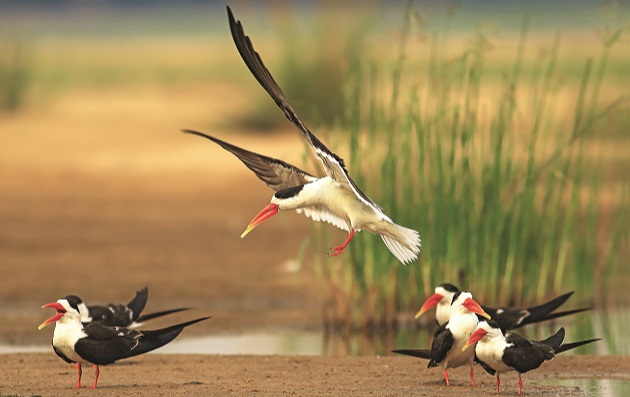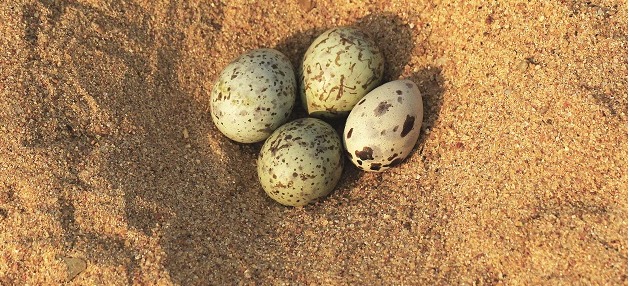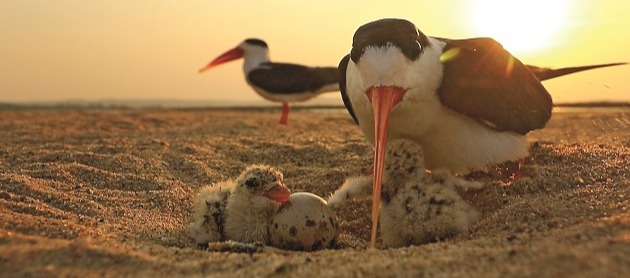Birds In The Sand
First published in Sanctuary Asia,
Vol. 36
No. 6,
June 2016
By Sumant Kumar Rajguru
In February 2016, on one of my routine birding trips to watch wintering migrants, I was surprised to spot a couple of Indian Skimmers flying above the Mahanadi river at the Munduli barrage, Chandaka Wildlife Division in Cuttack. It was surprising because they had appeared much earlier than usual in this habitat. Were the skimmers nesting nearby? Bird experts in the state had always pondered this but had been unable to confirm.
I did not expect to see the skimmers when I returned a day later. To my delight, a small flock had congregated on a sand bed in the middle of the river. There were Little Pratincoles, River Terns, Little Terns, River Lapwings, Great Thick-knees and a few Black-bellied Terns. I photographed them and informed my regular co-birdwatcher Panchami Manoo Ukil about the unexpected sightings. I was joined by another birder Saraju Dash the next day and we observed around 11 individuals displaying gregarious flocking behaviour and occasionally skimming the water. On subsequent visits over the next few days, I observed that the numbers were multiplying gradually and there was some pre-mating and nesting behaviour from Indian Skimmers, River Terns and Black-bellied Terns. I saw pairs of Indian Skimmers moving away from the flock and kicking-up sand to make a scrape in the bed. Some were also indulging in a kind of open-wing display, while others exhibited posturing typical of when they defend their nest scrape or mate.
Odisha’s Skimmers
Once presumed to be a winter visitor to Odisha, the Indian Skimmer has marked its presence in the state throughout the year in various habitats, especially in the Mahanadi river belt. The species has been sighted in Bhitarkanika, Nalabana in Chilika, Satkosia, Munduli in Cuttack, Dhamra and Hirakud. While the birds have been observed to be breeding in some of these places, no nesting site has yet been discovered.
In the Mahanadi at the Munduli barrage, though birders had sighted hundreds of these birds, no mating or pre-mating behaviour had been reported or documented.
Panchami joined me on March 11, 2016 and we spotted more than 60 skimmers on the sand-bar, which measured approximately 500-700 m. (varying with the recession and rise of the water level). Pairing and making of scrapes in the sand was observed. With each visit, I observed pre-mating behaviour between pairs of skimmers and occasionally by River Terns too. During a visit on March 22, when the mercury was touching 40o C, Panchami, Manas the boatman, and I came across a shallow nest scrape in the sand with a clutch of three eggs which we identified as those of a River Tern’s. We were elated that the egg-laying process had begun. I also observed a pair of Black-bellied Terns displaying nesting behaviour.
I returned the next day to witness some skimmers occupying the nests of the River Terns but they were eventually chased away by the owners. This behaviour seemed to reflect a maternal instinct although we later went on to discover something quite unusual. Meanwhile, closer to the edge of the sand bed, a flock of about 30 skimmers were sighted displaying courtship behaviour; the aerial chases and ground approaches indicative of pre-mating rituals.
Mating pairs
Two days later, an early morning visit revealed a flock of about 30 skimmers sitting in pairs on the sand. One skimmer stood guard while the other squatted on a shallow scrape. The distance between pairs was almost uniform. We edged a little closer and found that the troughs seemed large enough to indicate that egg-laying would commence soon.
I also found a Little Pratincole’s nest, again a shallow scrape in the sand, holding a clutch of small greenish eggs. On March 27, Avinash Khemka, Panchami Manoo Ukil, Manas, and I were privy to a pair of skimmers mating. The sequence of events was unfolding logically and the next morning, I was able to photograph and videotape another mating pair. The entire ritual lasted just about a minute and 40 seconds.

Indian Skimmers animatedly engaged in aerial chases and ground approaches as a part of their pre-mating rituals. Photo Courtesy: Sumant, Sudhanya and Siddhant Rajguru
New Life
On March 28, an adult bird was observed with an open vent while another adult bird had a largish bulge close to the vent, indicating that egg-laying would begin. We informed the PCCF (Wildlife) and Chief Wildlife Warden Siddhant Das, IFS, and DFO of the Chandaka Wildlife Division, Manoj Mahapatra who immediately surveyed the area and posted forest guards to prevent fishing boats and cattle grazers from disturbing the birds. Panchami, Avinash and I were authorised by the department to document the birds.
We also apprised local birdwatcher friends and sought their cooperation in protecting the site. Not one of them ventured into the area for more than 40 days, until the hatching was complete and the chicks were independent. Three local boys were entrusted with the responsibility of keeping a constant watch over the habitat.
I found the first egg on March 30. It looked distinctly different from the eggs of the terns. Gradually the nests began to fill up. On April 1st, I watched a miracle unfolding when a River Tern hatchling emerged from its egg. Manas and I placed light-coloured bricks a little away from the shallow nests to make markers on which we noted the nest number and the number of eggs. We took every precaution to ensure that the birds were not disturbed. Egg-laying took place over a period of three to five days. While the maximum number of eggs in River Tern nests were three, the number of eggs in the nests of Skimmers ranged between two and five. (There were 13 River Tern nests with 43 eggs while the total number of nests of Indian Skimmers was 58 with 181 eggs.) The number of birds in the congregating flock observed during the entire breeding period fluctuated between 136 and 205.

One unusual nest carried three tern eggs and a single skimmer egg. Photo Courtesy: Sumant, Sudhanya and Siddhant Rajguru

Under the golden rays of the morning sun, a female skimmer watches over her newly-hatched chicks as the male keeps vigil in the distance. Photo Courtesy: Sumant, Sudhanya and Siddhant Rajguru
Trouble in paradise
At about 3 p.m. on April 3, while I was away, I received a panicked call from Manas informing me of a water-level rise around the sand-bar. It was vital that it did not exceed 23 m. or the nests, especially the ones closest to the water’s edge, would be inundated. The three gates of the Puri Canal had been closed by the water regulating authorities. I informed the DFO and birding friends to request the authorities to open the gate but to no avail. Finally, on reaching Bhubaneswar at 9.30 a.m., I persuaded the official in-charge at the water control office to open at least one gate. The water began to recede but, as feared, a total of 13 nests were washed away.
I visited the nesting site twice every day to monitor nesting activity and to ensure that the nests were safe from cattle and human interference. We had to ward off grazing buffaloes from the sand-bar as some graziers would leave their cattle in the water and not regulate their movements.
I monitored and documented the frequency of visits to the nests by parent birds, their nest-cooling and incubating activities. The parent birds wet their bellies and sat on the eggs, perhaps to ensure that there was no over-heating, or to create humidity that was possibly conducive to hatching. I also found one nest, which strangely contained three eggs of a River Tern and one egg of the Indian Skimmer. Whether it indicates occasional brood-parasitism by skimmers is unknown but while the three eggs of the River Tern hatched successfully, the egg of the skimmer remained unhatched. During these documentations, the heat was oppressive, with the temperature on the sand-bar touching 48o C, with excessively high humidity. For us, three dips in the river every three hours was necessary to avoid suffering a sun-stroke.
The skimmers often foraged in small pot-holes in the sand, possibly feeding on arthropods. Two dead River Tern chicks were found with hoof marks close by indicating that they were trampled. Natural predation of eggs was observed by Asian Open-bills though the instances were few. River Terns were protective of all nests on the sand-bar. I requested researcher Dr. Sanjeet Kumar of the Regional Plant Resource Centre (RPRC), to survey and list all the flora in and around the sand-bar, and he drew up an extensive list of 48 species of sand-dune flora, five species of floating flora and seven species of submerged flora.
On April 19, the first Indian Skimmer chick hatched. I felt like a mother myself – having watched over the birds for the past 60 days. Panchami, Avinash and I had made detailed documentations of nesting behaviour, mainly through video-filming, and managed to obtain footage that has probably never been recorded before. All video-filming was conducted in the most unobtrusive manner, with the camera concealed under sand to ensure that the parent birds were not disturbed. Hatching of eggs continued successfully with low mortality though a second rise in water level led to the washing away of four nests with a total of 13 eggs. As of May 3, 2016, more than 100 eggs have successfully hatched with many of the juveniles now hopping around the sand-bar and foraging on tiny fish on their own. We are hoping to see the remaining 40 eggs hatch successfully. Juvenile River Terns are already undertaking flights for foraging while one juvenile Black-bellied Tern and one juvenile River Lapwing have also
been documented.
Experts from the Bombay Natural History Society (BNHS) also completed the first-ever ringing of Indian Skimmer juveniles. The ringed juveniles were observed to be maturing well and actively foraging on the sand-bar a week after ringing.
Odisha is blessed with an abundance of natural resources, much of which remains pristine and unexplored. It has been an enriching journey for me to understand the breeding and nesting success of Indian Skimmers. There was limited literature available and every effort was taken to protect and conserve the nesting habitat by my co-birdwatchers and me. Avian experts suggest that there has never been such detailed documentation of the breeding process of the Indian Skimmer. I hope that all the documentation will contribute towards strategizing long-term site-protection and conservation.
Observations:
Nest: On loose and dry sand. No nests on any part of the sand-bar that showed traces of silt. Distance between nests: 3.6 to 4.2 m., the pattern formed either rectangular or triangular.
Water ph level surrounding sand bar: 6.5.
Temperature during hatching: 42-44o C, the highest temperature recorded at 52o C on April 12. Humidity varied between 55-80 per cent.
Egg length: 42.5 mm.
Diameter at the centre: 30 mm.
Shape: Conically-oval
Colour: The base is more pale grey with bigger dark blotches. As the eggs matured, the colour became darker and more brownish, with the blotches turning a deep coppery-brown.
Parental role: Both parents alternated in cooling/incubating the eggs. After hatching, one parent would remove the broken egg shell from the nest scrape and throw it into the water. Parent birds fed the young hatchlings with regurgitation for the first two days. The hatchlings were observed to be semi-precocial, moving out of the nest by the third day and foraging for tiny fish at the river bank mostly at night.
Chick size: A five-day old chick was 110 mm. (beak-tip to tail-tip) and 135 mm. (wing-tip to wing-tip.) The length of tarsus was 65 mm. Length of beak was 20 mm. Both mandibles were equal in length. The chick weighed around 26 gm. Foraging by both adult and chicks mostly occurred at night.
Conservation strategies:
The Indian Skimmer Rynchops albicollis is classified as Vulnerable by IUCN and Birdlife International based on its fast depleting numbers which is assumed to be around 6,000 to 10,000 individuals. The species breeds in large rivers with broad, undisturbed sand-bank spits and islands. Since most of these places are remote and inaccessible, it is extremely difficult to conduct detailed observations on the conditions and habits of the species while it is breeding and nesting. Its distribution ranges from Pakistan through Nepal and India to Bangladesh and Myanmar. It was fairly commonly distributed in Myanmar, Laos, Cambodia, and Vietnam in the 19th century but recent records from these areas have been few and far between. There are also very few reports from Pakistan and Nepal.
Along with ringing, satellite telemetry could greatly help in monitoring their seasonal movements and help to formulate protection strategies. Stringent site-protection and regular monitoring/survey of the area with the collaboration of the Forest Department, Water Resources Department, Irrigation Department, NGOs and birdwatcher volunteers is of utmost importance so that the Mahanadi sand-bar remains safe for the species to nest here annually.
As the site is very close to human habitation (semi-urban area), it is imperative that awareness is generated among the locals so that fishing and cattle-grazing activities are not conducted in and around the site during the nesting period.
Take Action




